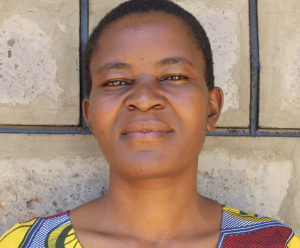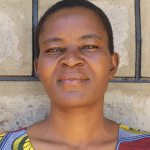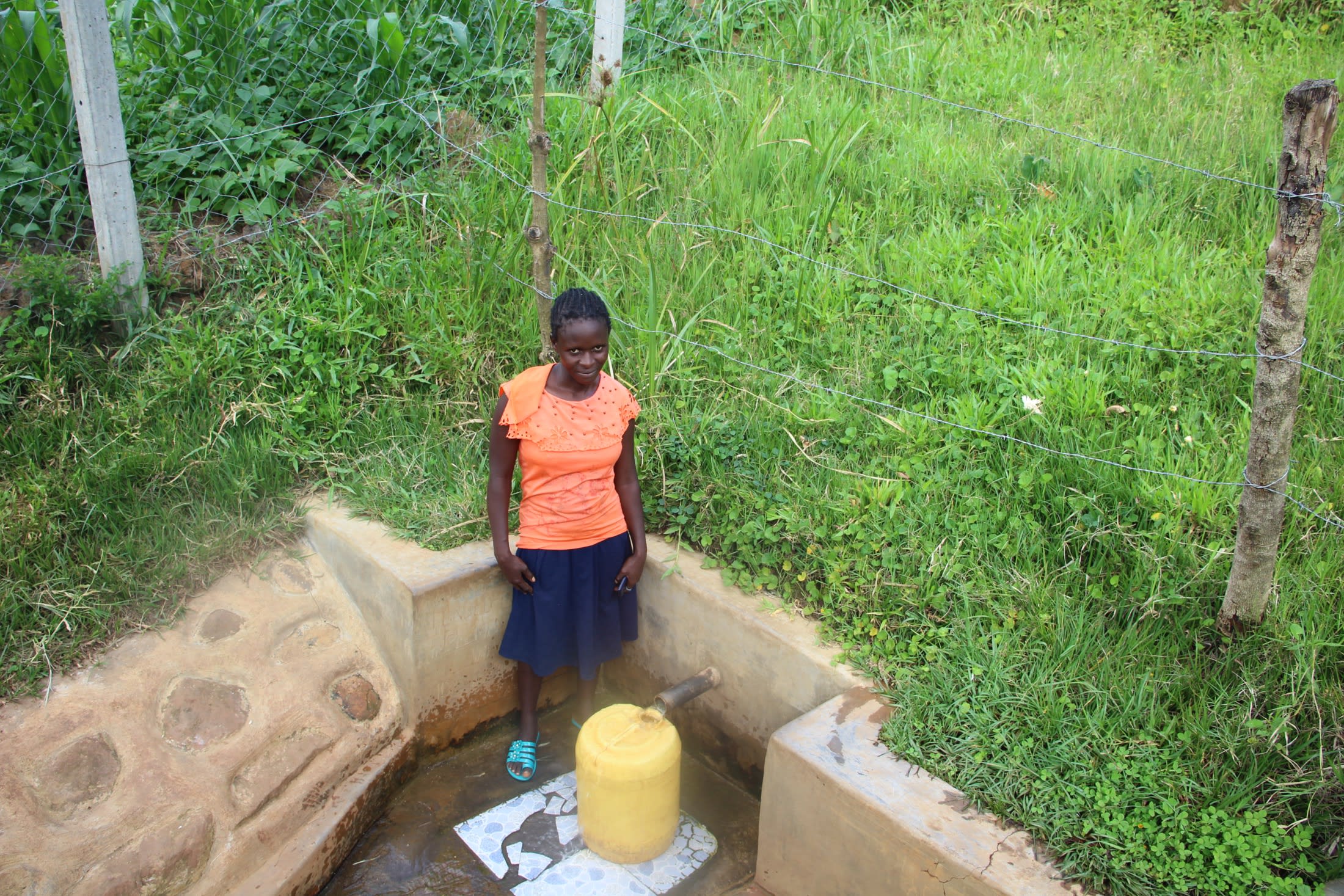In the Lukala West Community, people wake up around 5:00 am and the first thing that rings in their mind is that they have to fetch water before sunrise and before it is contaminated. Mostly women and children representing the 230 people who depend on Angatia Spring in Lukala West then head out to fetch water before doing anything else.
At the spring, accessing the water is a major challenge. The environment around this water point is not clean, and it is surrounded by bushes and reeds. The waterpoint is located on a steep slope, which makes it hard for community members to enter and leave the spring, especially during the rainy season when the path becomes slick with mud. Falls and their related injuries are not unheard of from trying to leave the spring when the ground is wet.
To aid in fetching water, community members created a makeshift discharge pipe using a plastic bottle with an open top lodged into a wall of mud they built. The water is then forced to flow through the bottle. But a lot of water seeps up through the ground around the bottle, reducing the current output. And to reach the pipe, people must balance among rocks and the pool of water always below the mud wall, risking slipping off the rocks if they use them or tripping in the mud if they don't.
The tricky access point slows people down as they fill their jerrycans, leading to long queues at the spring that waste a lot of time. Hence the early and late hours women try to fetch water. Yet they always seem to be waiting for someone ahead of them, even when they come back to the spring as late as 6:30 pm for the water they need for evening cooking, chores, and bathing.
"I am so scared whenever I go to the spring that I will fall down and hurt myself. I also waste alot of time at the spring because of the queue, and when I go back home, I have quarrels with my parents for taking so long," said primary school aged Brenda.
Angatia Spring's water is highly contaminated with animal waste, soil, and farm chemicals. Community members reported adverse health consequences after drinking this spring water including typhoid, diarrhea, and vomiting. People also noted the high rate of malaria among families who depend on this spring, which serves as an excellent breeding ground for the mosquitoes that carry the disease.
"We as a family are affected by the water from this water point. We are always seeking medication in order to treat typhoid, which is expensive. My business is affected and as a family, we are suffering a financial crisis," said Violet Ekeri, a 38-year-old businessperson and mother in Lukala West.
For those businesses that depend on water, like Violet's, Angatia Spring hurts them professionally as well in other respects. Due to poverty levels in the community, the business owners cannot afford to purchase bottled water from shops. This forces them to use the spring water or other questionable sources, which are not safe for drinking and cooking. The resulting poor-quality food, drinks, and other products made with the water lose customers. Some people avoid businesses known to use the dirty spring water altogether.
What We Can Do:
Spring Protection
Protecting the spring will help provide access to cleaner and safer water and reduce the time people have to spend to fetch it. Construction will keep surface runoff and other contaminants out of the water. With the community’s high involvement in the process, there should be a good sense of responsibility and ownership for the new clean water source.
Fetching water is a task predominantly carried out by women and young girls. Protecting the spring and offering training and support will, therefore, help empower the female members of the community by freeing up more of their time and energy to engage and invest in income-generating activities and their education.
Training on Health, Hygiene, COVID-19, and More
To hold trainings during the pandemic, we work closely with both community leaders and the local government to approve small groups to attend training. We ask community leaders to invite a select yet representative group of people to attend training who will then act as ambassadors to the rest of the community to share what they learn. We also communicate our expectations of physical distancing and wearing masks for all who choose to attend.
The training will focus on improved hygiene, health, and sanitation habits in this community. We will also have a dedicated session on COVID-19 symptoms, transmission routes, and prevention best practices.
With the community’s input, we will identify key leverage points where they can alter their practices at the personal, household, and community levels to affect change. This training will help to ensure participants have the knowledge they need about healthy practices and their importance to make the most of their water point as soon as water is flowing.
Our team of facilitators will use a variety of methods to train community members. Some of these methods include participatory hygiene and sanitation transformation, asset-based community development, group discussions, handouts, and demonstrations at the spring.
One of the most important issues we plan to cover is the handling, storage, and treatment of water. Having a clean water source will be extremely helpful, but it is useless if water gets contaminated by the time it is consumed. We and the community strongly believe that all of these components will work together to improve living standards here, which will help to unlock the potential for these community members to live better, healthier lives.
We will then conduct a small series of follow-up trainings before transitioning to our regularly scheduled support visits throughout the year.
Training will result in the formation of a water user committee, elected by their peers, that will oversee the operations and maintenance of the spring. The committee will enforce proper behavior around the spring and delegate tasks that will help preserve the site, such as building a fence and digging proper drainage channels. The fence will keep out destructive animals and unwanted waste, and the drainage will keep the area’s mosquito population at a minimum.

 Protected Spring
Protected Spring
 Rehabilitation Project
Rehabilitation Project
































